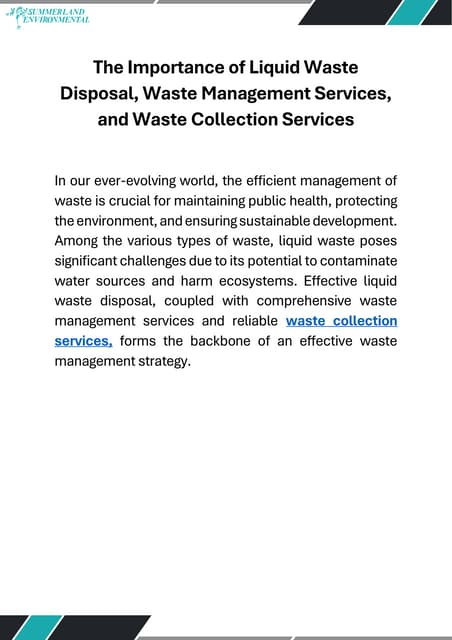Excitement About Reclaim Waste
Excitement About Reclaim Waste
Blog Article
Not known Facts About Reclaim Waste
Table of ContentsThe 45-Second Trick For Reclaim WasteThings about Reclaim Waste10 Easy Facts About Reclaim Waste ShownThe Single Strategy To Use For Reclaim WasteFascination About Reclaim WasteThe smart Trick of Reclaim Waste That Nobody is Discussing

Never place hazardous materials down sinks, toilets or stormwater drains Materials including petroleum, oil, oil, pesticides and herbicides, and solvents such as paint pole dancers need to not be poured down sinks, bathrooms or stormwater drains pipes. These compounds are tough to remove in the sewage therapy procedure and cause air pollution problems in our local waterways.

Although liquid waste is a term that covers a broad selection of materials, there's a great reason leaving its disposal to the professionals is suggested. Liquid waste is non-solid material that has no additional usage and must be treated and dealt with according to regional, state and government regulations.
The Single Strategy To Use For Reclaim Waste
Although examples of liquid waste can include wastewater, fats, oils or grease, used oil, liquids, solids, gases or sludges and dangerous home fluids, there are some that are taken into consideration to be more hazardous than others when it comes to the setting and the wellness of pets and people alike. It's for this factor that each state and area have rigorous laws linked to liquid waste monitoring.
Fluid waste can be stored in holding tanks or packaged in drums, intermediate mass containers or authorized small containers prior to either being treated or eliminated through outsourced vacuum cleaner trucks. Offered the nature of the materials, liquid waste can not go in the basic waste stream and there are stringent regulations on exactly how to take care of it properly.
(https://reclaimwaste1.creator-spring.com)Depending on a determination of the degree of danger, it may be essential to remediate those sites. In addition, unsafe liquid chemical wastes are regulated waste and has to be tracked according to the state waste legislation. Under the chain of wardship and duties, owners are liable and responsible for waste generated by an organization.
One of the core applications for superabsorbent polymers (SAPs) is fluid waste solidification. industrial wastewater treatment. SAPs are used by waste monitoring experts to stop possibly harmful liquids from entering rivers, groundwater aquifers, and other sensitive environments. Since fluids can quickly carry contaminants into ecological receptors and potentially contribute to geotechnical failings, fluid wastes are practically always forbidden from disposal in land fills
Reclaim Waste Can Be Fun For Anyone
Essentially, cost-free fluids are fluids that divide from the strong section of waste material. Fluid waste can consist of the following: HDD mud and cuttings Landfill leachate Wastewater treatment sludge & biosolids Dug up debris Oil and gas drill cuttings Clearing up pond filth Hydro Excavation slurry Coal combustion residuals/ash Container base sludge Concrete grinding/polishing slurry Relevant Write-up: For a useful example of totally free liquids dividing from waste material, take into consideration the complying with scenario: A waste monitoring professional loads a dump associate sludge from a wastewater therapy plant's aeration container, during a regular maintenance occasion.
When the motorist gets here at the landfill, he notifications water seeping from the sludge and putting from the dump truck. The lots was denied by the garbage dump and the chauffeur was compelled to throw away the waste as a liquid waste at a special center, which enhanced the disposal fees significantly.
We also need to be liable for the appropriate disposal of our waste materials. It is not sufficient that we pay waste disposal firms to take care of our rubbish.
A Biased View of Reclaim Waste

Segregating your waste can begin inside the home. Set apart completely dry and fluid waste as well as edible waste, naturally degradable and non-biodegradable products.
You can make use of old garbage container, pail, garden pot or old plastic drums. Pierce 4 to 5 holes in the container so the air can flow. Layer all-time low with soil to absorb the damp waste. Beginning the composting process. Layer the garden compost with wet and completely dry waste along with soil to preserve a balance between the damp and the completely dry.
The Facts About Reclaim Waste Uncovered
To promote faster decay, you can also include semi composted soil to the garden compost. If you observe the smell is ending up being as well solid, include extra newspapers and paper waste or add even more openings to the garden compost container to maintain the equilibrium of the waste materials.
We also require to be responsible for the correct disposal of our waste products. It is not enough that we pay waste disposal companies to take treatment of our rubbish.
Our waste, our responsibility. Have you ever questioned what takes place to your fluid waste after it's collected? Did you understand that fluid waste can be reused? As More Bonuses liable residents, you must comprehend what happens to your rubbish and where it goes after it is removed from you. Understanding the fluid waste removal procedure is necessary in assisting you to segregate your waste.
The Buzz on Reclaim Waste
Segregating your waste can start inside the home. Segregate dry and liquid waste as well as edible waste, biodegradable and non-biodegradable materials.
You can utilize old garbage can, container, yard pot or old plastic drums. Pierce 4 to 5 holes in the container so the air can flow. Layer the base with dirt to take in the damp waste. Begin the composting procedure. Layer the garden compost with damp and completely dry waste in addition to soil to preserve an equilibrium in between the damp and the dry.
To promote faster decay, you can also include semi composted dirt to the compost. If you see the odor is becoming also strong, include additional newspapers and paper waste or add even more holes to the garden compost bin to maintain the equilibrium of the waste materials.
Report this page